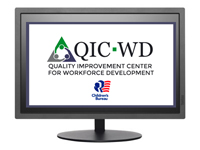Child Welfare Quality Improvement Center for Workforce Development (QIC-WD)
Date of this Version
6-2019
Document Type
Article
Citation
© The Quality Improvement Center for Workforce Development (QIC-WD)
Abstract
Staff recruitment, selection, and retention are persistent challenges for many child welfare agencies. Agency directors recognize these challenges but often lack the capacity or strong relationships with human resources (HR) to hire and keep the right child welfare staff. The lack of evidence-based practices to address child welfare workforce issues compounds the situation. The Quality Improvement Center for Workforce Development (QIC-WD) was created through a 5-year cooperative agreement with the Children's Bureau to advance knowledge about evidence-informed workforce interventions, test a variety of interventions in real-world settings, and examine how workforce stability is related to outcomes for children.
The QIC-WD partnered with eight child welfare agencies (including state, county, and tribal systems) to test the effectiveness of promising workforce interventions. Each site identified an implementation team made up of agency leadership, caseworkers, supervisors, HR professionals, quality assurance/continuous quality improvement staff, and training administrators. The QIC-WD provides workforce, implementation, and evaluation specialists, known as a WIE team, to work with each site.
The QIC-WD created a continuous workforce development process (adapted from the implementation and evaluation approach developed by the Permanency Innovations Initiative) to guide its work selecting, implementing, and evaluating workforce interventions. The first phase of this process is exploration, which includes a comprehensive workforce needs assessment to identify a specific workforce problem, who it affects, why it exists, and barriers or facilitators to addressing the problem; a theory of change for how to improve it; and an intervention to address it. Exploration is followed by the installation, initial implementation, and full implementation phases. Each phase includes significant teaming and evaluation components.
Many types of data are used to inform the assessment, such as HR recruitment, hiring, and retention metrics; agency records, such as exit surveys or past evaluation studies; organizational culture and climate survey results; and data on agency readiness for change. The WIE teams work with each site to provide context and additional qualitative information not available through existing data sources.
The QIC-WD learned a variety of valuable lessons about this process:
- The assessment takes months to complete because it is a data-driven process where one question often leads to more questions.
- Agencies vary in the extent to which they track the necessary data to accurately calculate employee turnover. In some cases, HR and program staff have limited experience working together and are not fully aware of all the available data across the two departments.
- Very few public child welfare agencies have a unique identifier in place to link employee HR data to child welfare case outcomes.
- Conducting a comprehensive workforce needs assessment is new to most public child welfare agencies.
The assessment is only the first step in a continuous workforce development process, yet it is crucial because it is the foundation for the implementation and evaluation activities that come next. For more information visit the QIC-WD website (https://www.qic-wd.org/) or attend the Children's Bureau Evaluation Summit in August 2019.
For more information, contact Michelle Graef, project director for the QIC-WD, University of Nebraska-Lincoln, Center on Children, Families and the Law at mgraef1@unl.edu.
Included in
Industrial and Organizational Psychology Commons, Public Administration Commons, Social Welfare Commons, Social Work Commons, Work, Economy and Organizations Commons


